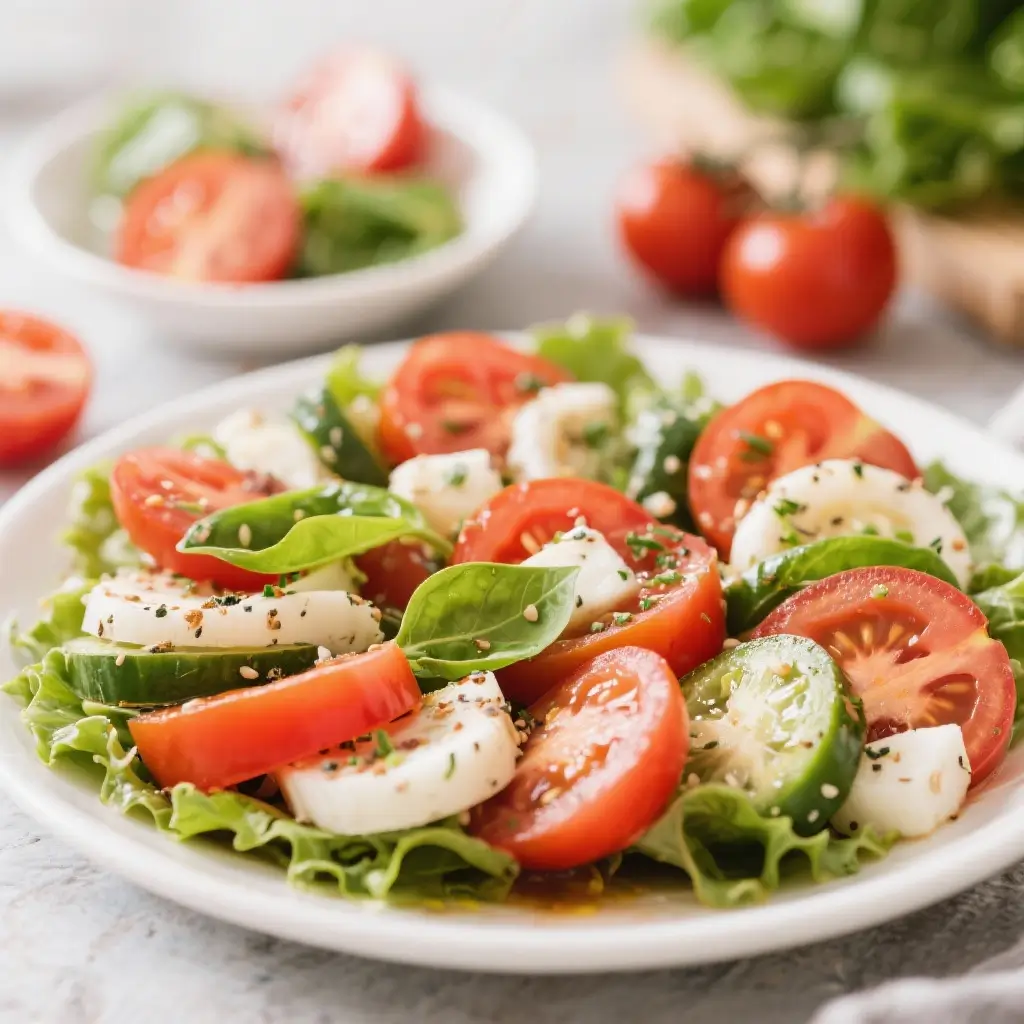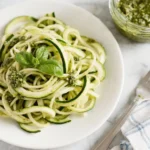Introduction
The Caprese salad, a timeless classic from the sun-drenched regions of Italy, is a celebration of simplicity and fresh, high-quality ingredients. Revered for its vibrant colors that mirror the Italian flag—red, white, and green—this dish is more than just a salad; it’s a symbol of culinary elegance rooted in tradition. Originating from the island of Capri in the Campania region, the Caprese has transcended borders to become a staple on menus around the world. Its appeal lies not only in its visual beauty but also in its ability to deliver a burst of flavor with minimal effort. Whether served as an appetizer, a light lunch, or a refreshing side dish, the Caprese salad embodies the essence of Mediterranean cuisine: fresh, wholesome, and deeply satisfying.
The History
The origins of the Caprese salad trace back to the early 20th century on the picturesque island of Capri, located off the southern coast of Italy. While various legends surround its inception, one popular theory attributes its creation to a patriotic chef seeking to honor the unification of Italy by crafting a dish that mirrored the national flag. The red of ripe tomatoes, the white of fresh mozzarella, and the green of basil leaves came together in perfect harmony, creating both a visual and gustatory tribute to the nation. Another story suggests that the salad was first served in aristocratic homes on Capri during the summer months, where local farmers proudly offered their freshest produce. Over time, the Caprese gained popularity beyond the island, embraced by restaurants across Italy and eventually making its way into global culinary culture. Today, it stands as a beloved emblem of Italian gastronomy, often associated with warm summers, family gatherings, and the slow food movement that values seasonal, locally-sourced ingredients.
Ingredients Breakdown
The magic of the Caprese salad lies in its minimalism—only a few premium ingredients are needed, each playing a crucial role in balancing flavor, texture, and appearance. At the heart of the dish are three primary components: ripe tomatoes, fresh mozzarella cheese, and aromatic basil leaves. The tomatoes should be firm yet juicy, ideally vine-ripened or heirloom varieties like Roma, Beefsteak, or San Marzano, which offer a rich sweetness and deep red hue. Fresh mozzarella, preferably buffalo mozzarella (mozzarella di bufala), is essential for its creamy texture and mild, milky flavor. Unlike aged or low-moisture mozzarella, fresh mozzarella contains more moisture, contributing to the salad’s luscious mouthfeel. Basil adds a fragrant, slightly peppery note that complements the other ingredients without overpowering them. High-quality extra virgin olive oil drizzled generously over the top enhances richness and helps carry the flavors. A sprinkle of flaky sea salt—such as Maldon—brings out natural sweetness, while freshly ground black pepper adds a subtle warmth. Optional additions include a balsamic glaze or reduction for a touch of acidity and sweetness, though purists may argue that true Caprese requires nothing more than the core ingredients and olive oil.
Step-by-Step Recipe
- Select Your Ingredients: Begin by sourcing the finest available ingredients. Choose perfectly ripe, firm tomatoes that yield slightly under gentle pressure. Opt for fresh mozzarella packed in water to ensure maximum freshness and creaminess. Pick large, vibrant green basil leaves free from blemishes.
- Prepare the Tomatoes: Wash the tomatoes thoroughly under cool running water. Pat them dry gently with a clean kitchen towel. Using a sharp serrated knife, slice the tomatoes into even rounds about ¼ to ½ inch thick, depending on your preference and the size of the tomatoes.
- Drain the Mozzarella: Remove the mozzarella from its liquid and place it on a paper towel-lined plate. Gently pat the cheese to remove excess moisture. This prevents the salad from becoming too watery. Slice the mozzarella into rounds similar in thickness and diameter to the tomato slices.
- Wash and Dry Basil Leaves: Rinse the basil leaves under cold water to remove any dirt. Lay them out on a clean towel or use a salad spinner to dry completely. Wet basil can dilute flavors and make the dish soggy.
- Assemble the Salad: On a large serving platter or individual plates, begin layering. Alternate slices of tomato and mozzarella in a circular or linear pattern, slightly overlapping each piece. Tuck whole or torn basil leaves between the layers. For a more rustic presentation, you can stack them in small towers.
- Season Generously: Sprinkle the assembled salad with flaky sea salt and freshly cracked black pepper. Be generous with the salt—it enhances the natural sweetness of the tomatoes and balances the mildness of the mozzarella.
- Drizzle with Olive Oil: Use a high-quality extra virgin olive oil. Slowly drizzle it over the entire surface of the salad, ensuring every bite will have a hint of its fruity, peppery notes.
- Add Optional Balsamic Glaze (Optional): If desired, lightly drizzle a balsamic reduction or glaze in a decorative pattern over the top. Avoid using raw balsamic vinegar, as its sharp acidity can overwhelm the delicate balance of flavors.
- Serve Immediately: The Caprese salad is best enjoyed fresh, at room temperature. Serve within 15–30 minutes of assembly to maintain optimal texture and flavor.
Tips
- Use Room Temperature Ingredients: Take the mozzarella and tomatoes out of the refrigerator at least 30 minutes before assembling. Cold ingredients dull the flavors and textures.
- Choose Seasonal Tomatoes: The success of a Caprese salad depends heavily on tomato quality. Summer is the ideal season when tomatoes are naturally sweet and flavorful.
- Don’t Over-Slice: Keep slices thick enough to hold their shape and provide a satisfying bite. Thin slices may become mushy.
- Handle Basil Gently: Tear basil leaves by hand rather than cutting with a knife to prevent bruising and oxidation, which can lead to bitterness.
- Balsamic Reduction Tip: If making your own balsamic glaze, simmer 1 cup of balsamic vinegar over low heat until reduced by half and syrupy. Cool before drizzling.
- Serving Platter Matters: Use a wide, flat platter to allow air circulation and showcase the beautiful arrangement. Marble slabs or wooden boards add aesthetic appeal.
- Avoid Dressing Too Early: Adding olive oil and salt too far in advance can cause the tomatoes to release water, making the salad soggy.
- Fresh Is Best: Never substitute dried basil or pre-shredded mozzarella. These compromise both taste and texture.
Variations and Customizations
While the traditional Caprese salad remains a gold standard, creative variations allow home cooks to personalize the dish while honoring its roots. One popular twist includes adding avocado slices for a creamy contrast and healthy fats, turning it into a “California-style” Caprese. Grilled peaches or nectarines introduce a summery sweetness that pairs beautifully with the savory elements. For a modern presentation, try a deconstructed Caprese skewer: thread cherry tomatoes, mini mozzarella balls (bocconcini), and folded basil leaves onto toothpicks or small skewers for an elegant appetizer. Some chefs incorporate heirloom tomatoes of different colors—yellow, purple, orange—to create a rainbow effect on the plate. Another variation involves using burrata instead of mozzarella; this ultra-creamy cheese oozes luxuriously when cut, elevating the indulgence factor. Herb swaps like arugula, mint, or microgreens can refresh the profile, while edible flowers such as nasturtiums or pansies add visual drama. For a protein boost, top the salad with grilled chicken, shrimp, or prosciutto. Vegan versions utilize plant-based mozzarella made from cashews or almond milk, paired with marinated tofu or tempeh. Even dessert interpretations exist, such as the “Fruit Caprese,” where strawberries stand in for tomatoes, vegan mozzarella for cheese, and basil remains unchanged—a sweet homage to the original.
Health Considerations and Nutritional Value
The Caprese salad is not only delicious but also offers several health benefits when enjoyed in moderation. Tomatoes are rich in lycopene, a powerful antioxidant linked to reduced risk of heart disease and certain cancers. They also provide vitamin C, potassium, folate, and vitamin K. Fresh mozzarella is lower in sodium and fat compared to many aged cheeses, making it a relatively healthier dairy option. It supplies calcium for bone health and protein for satiety. Basil contributes anti-inflammatory and antimicrobial properties, thanks to compounds like eugenol, and is a good source of vitamin A, iron, and magnesium. Extra virgin olive oil, a cornerstone of the Mediterranean diet, is loaded with monounsaturated fats and polyphenols that support cardiovascular health and reduce inflammation. However, due to the fat content in cheese and olive oil, portion control is advisable, especially for those monitoring calorie intake. A typical serving (about 1 cup) contains approximately 250–350 calories, depending on the amount of cheese and oil used. To make a lighter version, opt for part-skim mozzarella, reduce the oil slightly, or increase the ratio of tomatoes and basil. Individuals with lactose intolerance should be cautious, though fresh mozzarella tends to be lower in lactose than many other cheeses. Those on low-FODMAP diets may need to limit or avoid garlic-infused olive oils if added. Overall, the Caprese salad aligns well with balanced eating patterns, emphasizing whole, unprocessed foods and heart-healthy fats.
Ingredients
- 4 medium ripe tomatoes (preferably heirloom or vine-ripened)
- 8 oz (about 225g) fresh mozzarella (buffalo or cow’s milk), sliced
- 1 large bunch fresh basil leaves (about 20–25 leaves)
- ¼ cup high-quality extra virgin olive oil
- 1 tsp flaky sea salt (or to taste)
- Freshly ground black pepper (to taste)
- 2 tbsp balsamic glaze (optional)
Directions
- Wash and dry the tomatoes, then slice them into ¼-inch thick rounds. Set aside on a plate.
- Remove mozzarella from liquid and pat dry with paper towels. Slice into rounds matching the tomato size.
- Rinse basil leaves and pat dry thoroughly. Leave some whole, tear others for texture.
- On a large serving platter, arrange tomato and mozzarella slices in an alternating, slightly overlapping pattern.
- Nestle basil leaves throughout the layers, tucking them between tomato and cheese slices.
- Sprinkle flaky sea salt and freshly ground black pepper evenly over the salad.
- Slowly drizzle extra virgin olive oil over the top, covering all components.
- If using, lightly drizzle balsamic glaze in a zigzag pattern for visual appeal and tangy sweetness.
- Serve immediately at room temperature for the best flavor and texture.
FAQ
Can I make Caprese salad ahead of time?
It’s best served fresh, but you can prep ingredients separately up to 2 hours in advance. Assemble just before serving to prevent sogginess.
What kind of mozzarella should I use?
Fresh mozzarella in water (not vacuum-packed or low-moisture) is essential. Buffalo mozzarella offers superior flavor and texture.
Is balsamic glaze necessary?
No, it’s optional. Purists prefer only olive oil, salt, and pepper. Add it only if you enjoy a hint of sweetness and acidity.
Can I refrigerate leftover Caprese salad?
Not recommended. Refrigeration alters the texture of tomatoes and makes basil wilt. Consume within 1–2 hours of preparation.
Are there dairy-free alternatives?
Yes! Use high-quality vegan mozzarella made from nuts or coconut. Pair with extra basil and olive oil for richness.
Why are my tomatoes too watery?
Overripe tomatoes or cold storage can increase moisture. Use firm, ripe tomatoes and bring them to room temperature before slicing.
Can I grill the ingredients?
Absolutely! Grilled tomatoes and mozzarella (using smoked mozzarella) add a smoky depth. Try it in warmer months for a twist.
How do I store fresh basil?
Treat it like flowers: trim stems, place in a glass with water, cover loosely with a bag, and keep at room temperature away from sunlight.
Summary (in two lines)
The Caprese salad is a vibrant, fresh Italian classic that celebrates ripe tomatoes, creamy mozzarella, and fragrant basil, drizzled with olive oil and seasoned simply. Elegant in its simplicity, it captures the spirit of Mediterranean cuisine in every colorful, flavorful bite.










